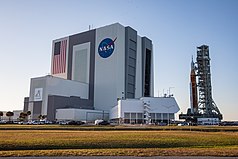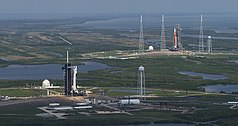
Back Kennedy-ruimtesentrum Afrikaans Kennedy Space Center ALS مركز كينيدي للفضاء Arabic Centru espacial John F. Kennedy AST Kennedi Kosmik Mərkəzi Azerbaijani Касмічны цэнтр Кенэдзі Byelorussian Космически център Джон Ф. Кенеди Bulgarian কেনেডি স্পেস সেন্টার Bengali/Bangla Svemirski centar "Kennedy" BS Centre Espacial John F. Kennedy Catalan
 | |
Along the clock, from the top: Vehicle Assembly Building, Launch and Landing Facility, Launch Control Center, Launch Complexes 39A and 39B, KSC Headquarters Building, and the Visitor Complex | |
 KSC shown in white; CCSFS in green | |
| Abbreviation | KSC |
|---|---|
| Named after | John F. Kennedy |
| Formation | July 1, 1962 |
| Type | NASA facility |
| Location | |
| Coordinates | 28°31′27″N 80°39′03″W / 28.52417°N 80.65083°W |
| Owner | NASA |
Director | Janet E. Petro[1] |
Budget | US$2.074 billion[2]: 52 (2023) |
Staff | 13,253[2]: 50 (2023) |
| Website | www |
Formerly called | Launch Operations Center |
| [3] | |
The John F. Kennedy Space Center (KSC) is a spaceport in Merritt Island, Florida. It is one of the ten field centers of NASA. It was originally known as Launch Operations Center. Since December 1968, KSC has been the main launch site of human spaceflight, research, and technology of the United States. Its Launch Complex 39 has been used to launch spacecraft under Apollo, Skylab and Space Shuttle programs.[4] KSC borders Cape Canaveral Space Force Station (CCSFS), which works with KSC.
The first Apollo flights and all flights under Project Mercury and Project Gemini took off from Cape Canaveral Space Force Station. It was known as Cape Canaveral Air Force Station (CCAFS) when the flights took place. Launch Operations Directorate, and later Kennedy Space Center, looked after after their launches.[5][6] Since the fourth Gemini flight, the Mercury Control Center (MCC), later the Launch Control Center (LCC), looks after a space vehicle until the vehicle takes off. After that, the Christopher C. Kraft Jr. Mission Control Center (MCC-H) in Houston looks after the vehicle. Before the fourth Gemini flight, the Mercury Control Center looked after the vehicle for the entire flight.[7][8]
Additionally, KSC looks after the launch of robotic and commercial crew flights. It also researches on food production and in-situ resource utilization to explore outside our Earth.[9] Since 2010, KSC has worked to become a multi-user spaceport through industry partnerships.[10] It also adds new launch pads, for example Launch Complex 39C and Launch Complex 48.
There are about 700 facilities and buildings in the 144,000 acres (580 square kilometers) of KSC.[11] The unique facilities of KSC are the 525-foot (160-meter) tall Vehicle Assembly Building (VAB) to assemble rockets, the Launch Control Center (LCC) to start space launches, the Operations and Checkout Building (O&C) for astronauts, the Space Station Processing Facility (SSPF) and the 3-mile (4.8-kilometer) long Launch and Landing Facility (LLF). There is also a Visitor Complex open to the public.
- ↑ Kennedy Space Center gets first woman director, Janet Petro, after Bob Cabana promoted to NASA.
- ↑ 2.0 2.1 "2023 Kennedy Space Center Annual Report" (PDF). NASA. Archived (PDF) from the original on January 2, 2024. Retrieved January 2, 2024.
- ↑ "Kennedy Business Report" (PDF). Annual Report FY2010. NASA. February 2011. Retrieved August 22, 2011.
- ↑ "Kennedy Space Center Implementing NASA's Strategies" (PDF). NASA. 2000. Archived from the original (PDF) on November 13, 2022. Retrieved November 5, 2015.
- ↑ "Appendix 10 – Government Organizations Supporting Project Mercury". NASA History Program Office. NASA. Retrieved November 6, 2015.
- ↑ "2. Project Support from the NASA Centers". Mercury Project Summary (NASA SP-45). NASA. Retrieved November 6, 2015.
- ↑ "Mercury Mission Control". NASA. Archived from the original on March 7, 2016. Retrieved November 6, 2015.
- ↑ Lipartito, Kenneth; Butler, Orville (2007). 'A History of the Kennedy Space Center. University Press of Florida. ISBN 978-0-8130-3069-2.
- ↑ "Research & Technology". Kennedy Space Center. NASA. March 3, 2015. Retrieved November 5, 2015.
- ↑ "NASA Partnerships Launch Multi-User Spaceport". NASA. May 1, 2014. Retrieved November 5, 2015.
- ↑ "Kennedy Creating New Master Plan". NASA. March 12, 2012. Archived from the original on May 27, 2020. Retrieved November 5, 2015.





